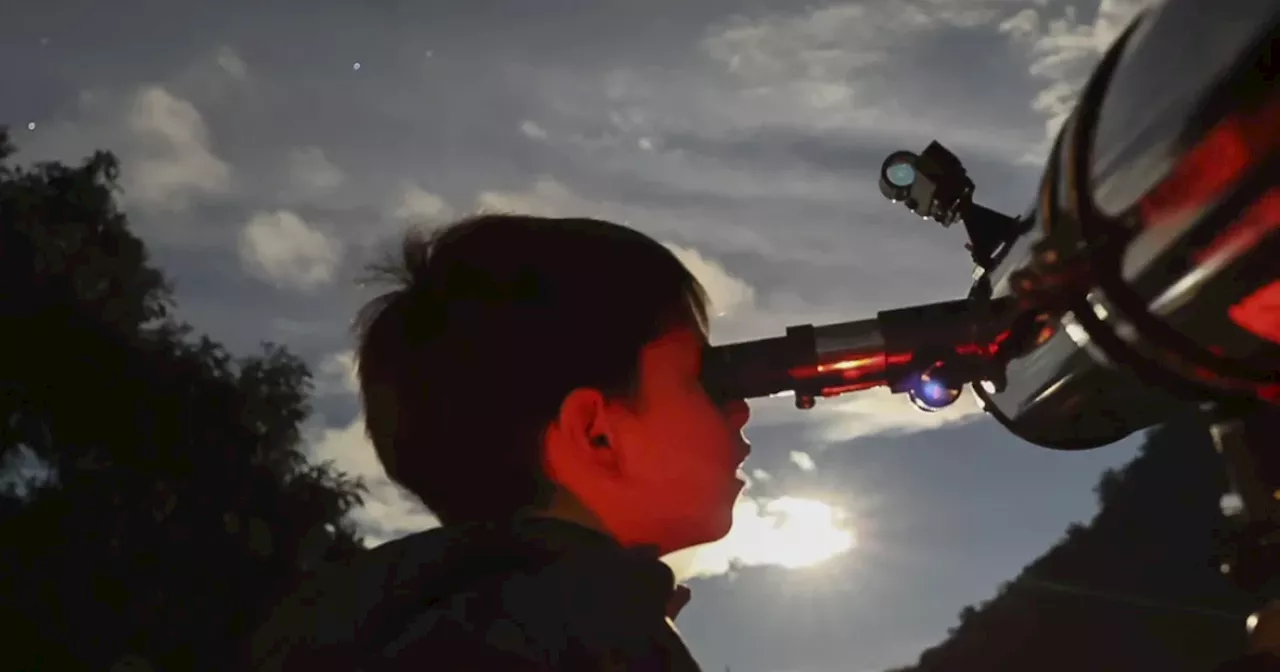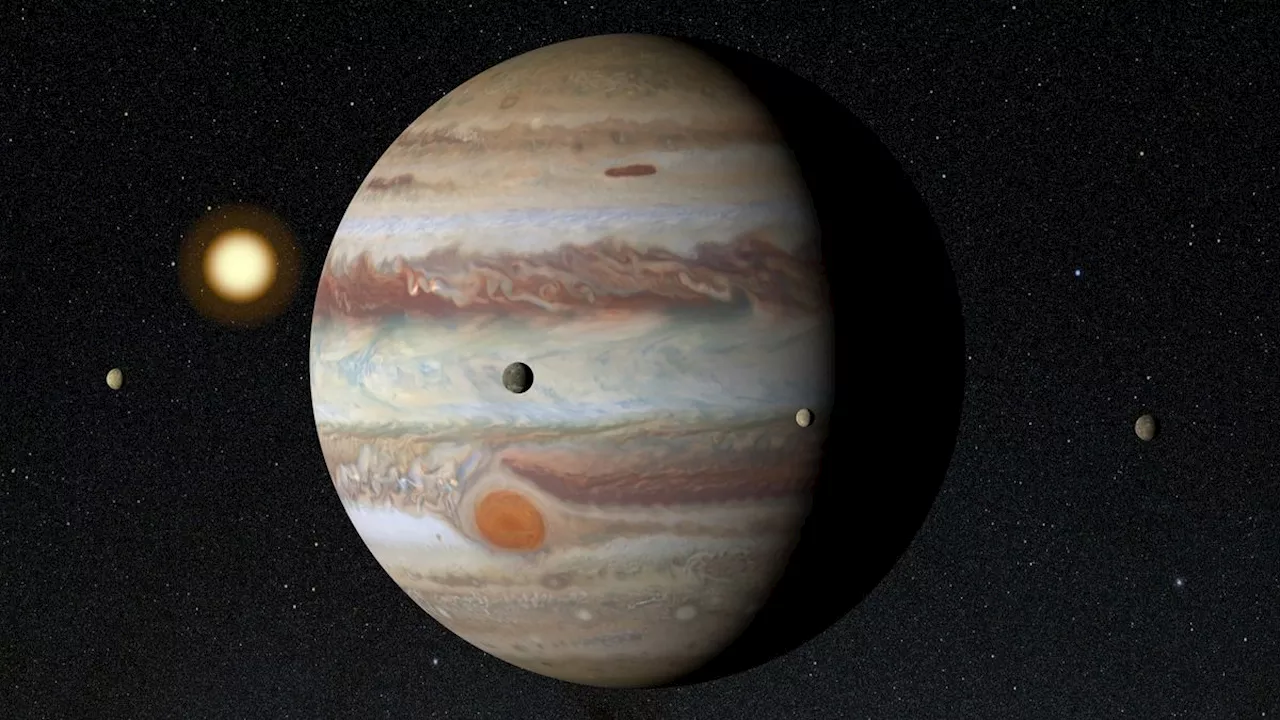Get ready for a celestial spectacle as Jupiter and Mars put on a show, appearing in close proximity to the moon over the next few nights. Jupiter will be first, shining just 5 degrees from the moon on Thursday night. Then, on Sunday, Mars will join the celestial dance, coming within 1 to 2 degrees of our lunar companion.
Jupiter will put on a celestial show this week, appearing extremely close to Earth's moon on Thursday night before Mars joins the cosmic dance on Sunday.The bright moon will serve as a backdrop for these planetary encounters, creating a spectacular sight for skywatchers. On Thursday night (from February 6 to 7), Jupiter will shine approximately 5 degrees away from the moon, while on Sunday (February 9), Mars will be a mere 1 to 2 degrees from our lunar companion.
To capture these celestial events, find a location with unobstructed, dark skies away from city lights. Allow your eyes to adjust to the darkness for optimal viewing. If you need illumination, opt for a red flashlight to preserve your night vision. On February 6-7, Jupiter and the moon will be in conjunction, meaning they will appear very close together in the sky. This conjunction will occur at 10:36 p.m. EST, and the two celestial bodies will remain close throughout the night. Look for Jupiter positioned slightly below the moon in the constellation Taurus. The moon will be in its waxing gibbous phase, around 70% illuminated. Both Jupiter and the moon will rise around noon local time on February 6 and set around 3:30 a.m. local time on February 7, making them visible from sunset to the early morning hours.A few nights later, on February 9, Mars and the moon will be in conjunction around 2:36 p.m. EST. At their closest point, they will be about half a degree apart. While this conjunction will occur during daylight hours for viewers in the United States and Canada, Mars will remain very close to the moon throughout the night. Shortly after sunset, they will be about 2 degrees apart, though this may vary depending on your location. Look for them in the eastern sky, within the constellation Gemini. Mars will be positioned above and slightly to the west of the waxing gibbous moon, which will be about 90% illuminated.Skywatchers in northern latitudes might even witness a lunar occultation, an event where the moon appears to eclipse a planet. Mars will disappear behind the moon around 1:09 p.m. EST and reappear about 4:30 p.m. EST. This lunar occultation will be visible from parts of Canada, most of Scandinavia and Russia, and some areas of Asia. The occultation will barely touch the northernmost part of the U.K
JUPITER MARS MOON CONJUNCTION LUNAR OCCULTATION
United States Latest News, United States Headlines
Similar News:You can also read news stories similar to this one that we have collected from other news sources.
 A planet parade of Venus, Saturn, Jupiter and Mars shines in the skies this monthAll month, Venus, Saturn, Jupiter and Mars will appear to line up and be bright enough to see with the naked eye in the first few hours after dark. This weekend, Venus and Saturn get especially cozy.
A planet parade of Venus, Saturn, Jupiter and Mars shines in the skies this monthAll month, Venus, Saturn, Jupiter and Mars will appear to line up and be bright enough to see with the naked eye in the first few hours after dark. This weekend, Venus and Saturn get especially cozy.
Read more »
 Shinedown Announces 'Dance, Kid, Dance Tour' with Pennsylvania StopRock band Shinedown is hitting the road in 2025 with their highly anticipated 'Dance, Kid, Dance Tour', featuring special guests Beartooth and Bush. The tour includes a stop in Pittsburgh, Pennsylvania on July 22nd.
Shinedown Announces 'Dance, Kid, Dance Tour' with Pennsylvania StopRock band Shinedown is hitting the road in 2025 with their highly anticipated 'Dance, Kid, Dance Tour', featuring special guests Beartooth and Bush. The tour includes a stop in Pittsburgh, Pennsylvania on July 22nd.
Read more »
 Stargazers Rejoice! Four Planets Visible in Alaska's Night SkyThis is an excellent time for stargazing in Alaska. After sunset, look towards the southwest to see Saturn and Venus shining brightly. Before 9:40 p.m., you can spot four planets with the naked eye: Saturn, Venus, Jupiter, and Mars. Jupiter and Mars remain visible through the morning, with Mars especially close to the moon. The Aurora forecast is weak for the next few weeks.
Stargazers Rejoice! Four Planets Visible in Alaska's Night SkyThis is an excellent time for stargazing in Alaska. After sunset, look towards the southwest to see Saturn and Venus shining brightly. Before 9:40 p.m., you can spot four planets with the naked eye: Saturn, Venus, Jupiter, and Mars. Jupiter and Mars remain visible through the morning, with Mars especially close to the moon. The Aurora forecast is weak for the next few weeks.
Read more »
 Virginia elections signal no major shift in voter sentiment in a state watched closely for cluesVirginia’s three special elections this week garnered national attention as Democrats protected their slim statehouse majority by winning two left-leaning districts.
Virginia elections signal no major shift in voter sentiment in a state watched closely for cluesVirginia’s three special elections this week garnered national attention as Democrats protected their slim statehouse majority by winning two left-leaning districts.
Read more »
 Virginia elections signal no major shift in voter sentiment in a state watched closely for cluesVirginia’s three special elections this week garnered national attention as Democrats protected their slim statehouse majority by winning two left-leaning districts.
Virginia elections signal no major shift in voter sentiment in a state watched closely for cluesVirginia’s three special elections this week garnered national attention as Democrats protected their slim statehouse majority by winning two left-leaning districts.
Read more »
 HKU study shows ruminating about being lonely is more closely linked to depression than actual lonelinessPast studies have identified a loneliness-rumination-depression nexus. Rumination is defined as repetitive and intrusive negative thoughts and feelings, and loneliness as a gap between desired and actual social connections.
HKU study shows ruminating about being lonely is more closely linked to depression than actual lonelinessPast studies have identified a loneliness-rumination-depression nexus. Rumination is defined as repetitive and intrusive negative thoughts and feelings, and loneliness as a gap between desired and actual social connections.
Read more »
